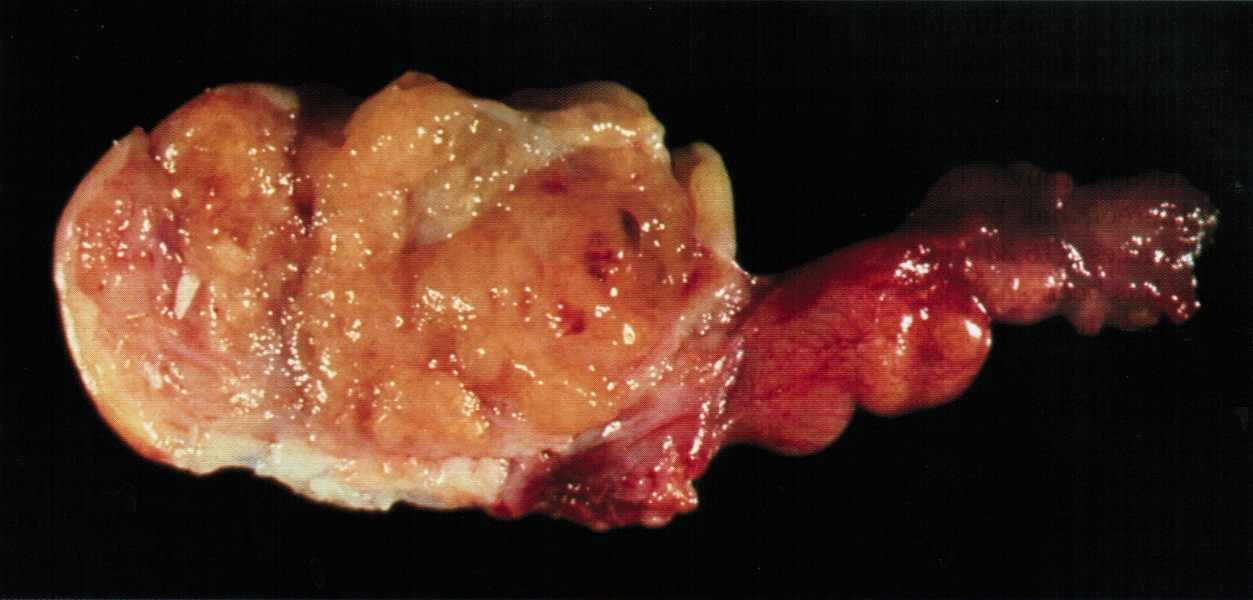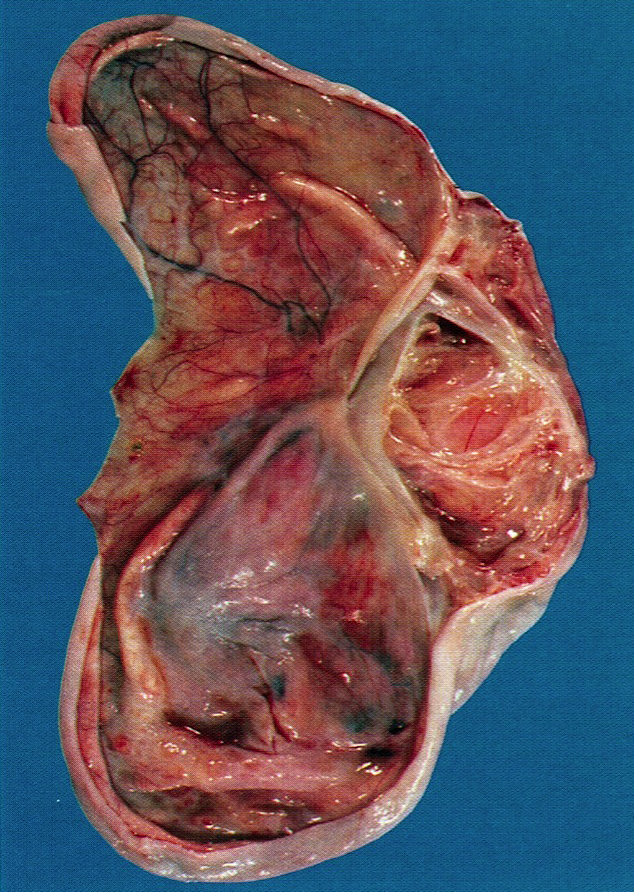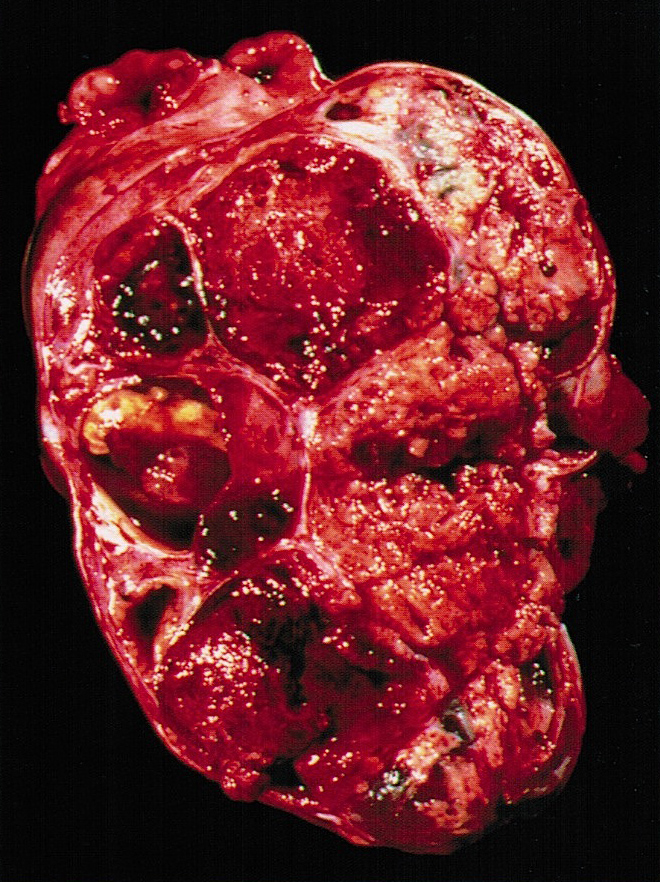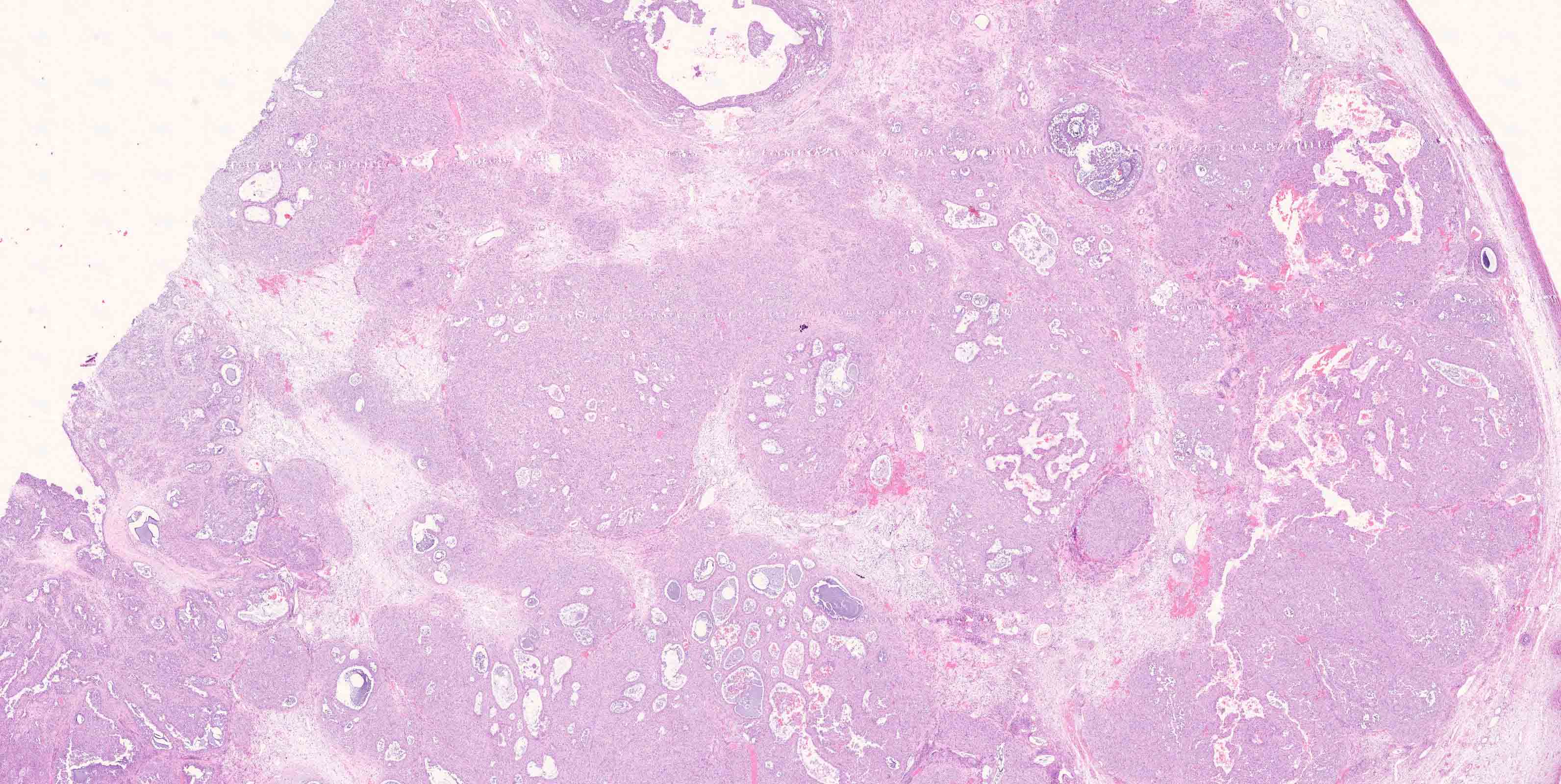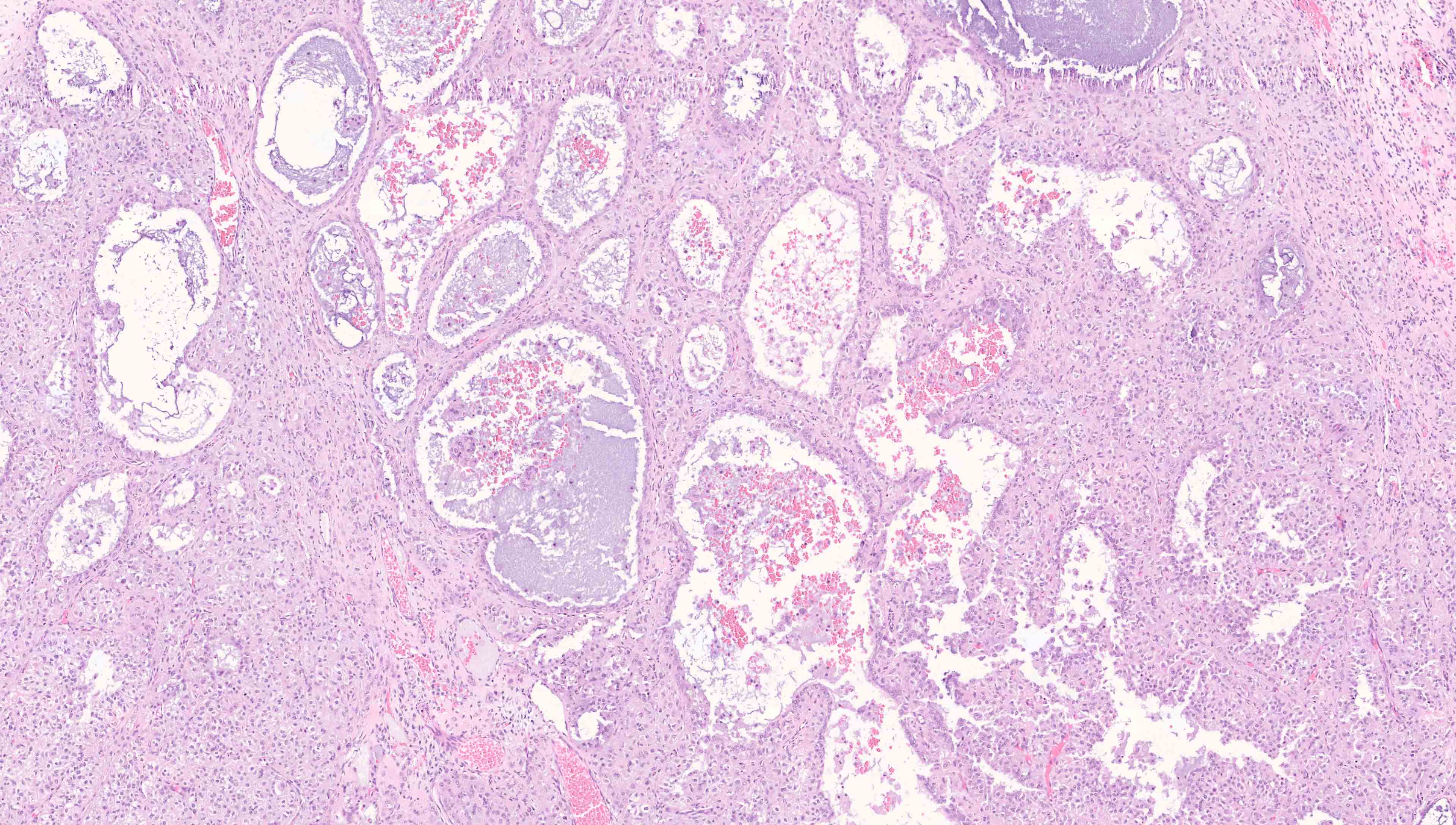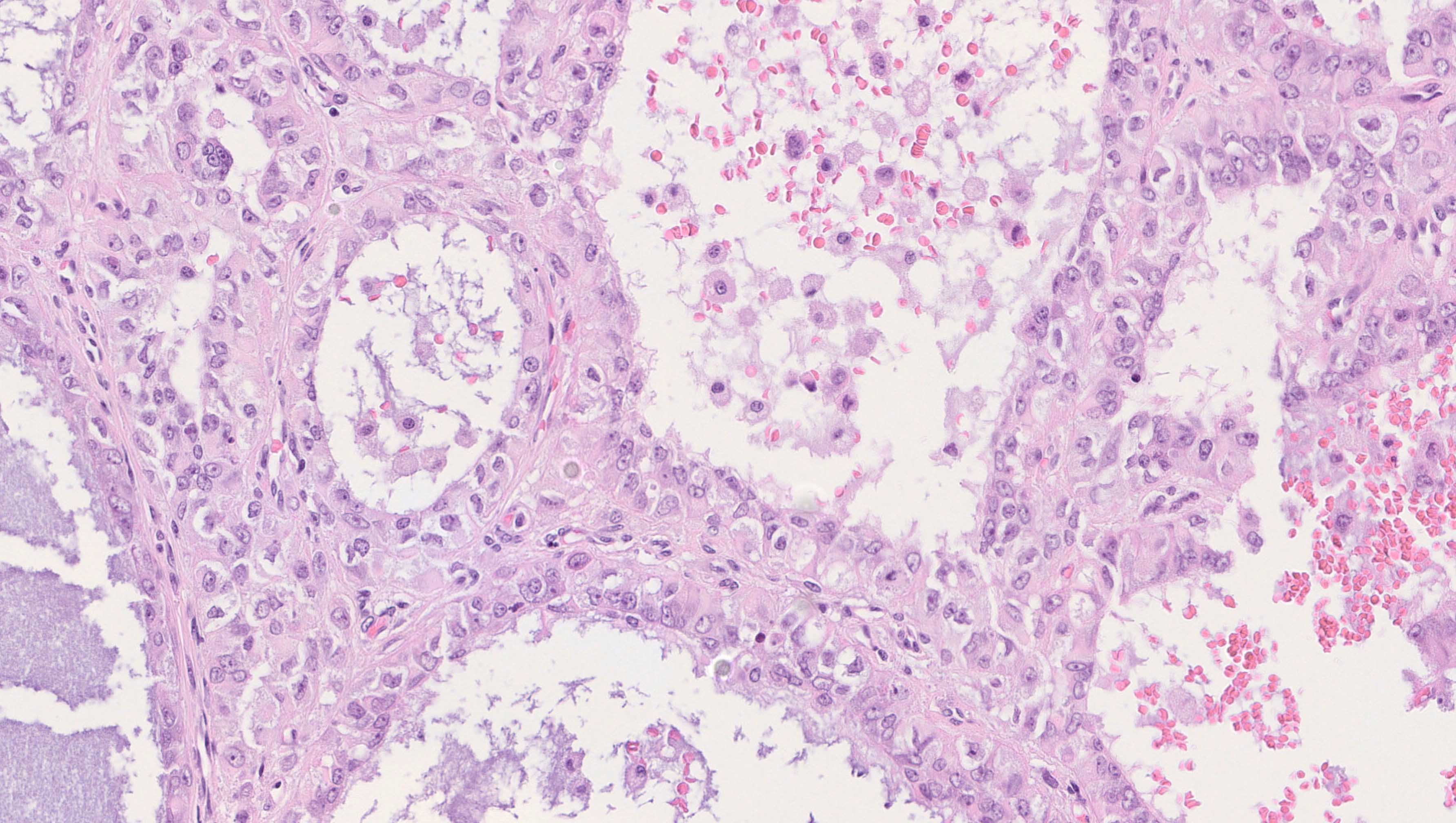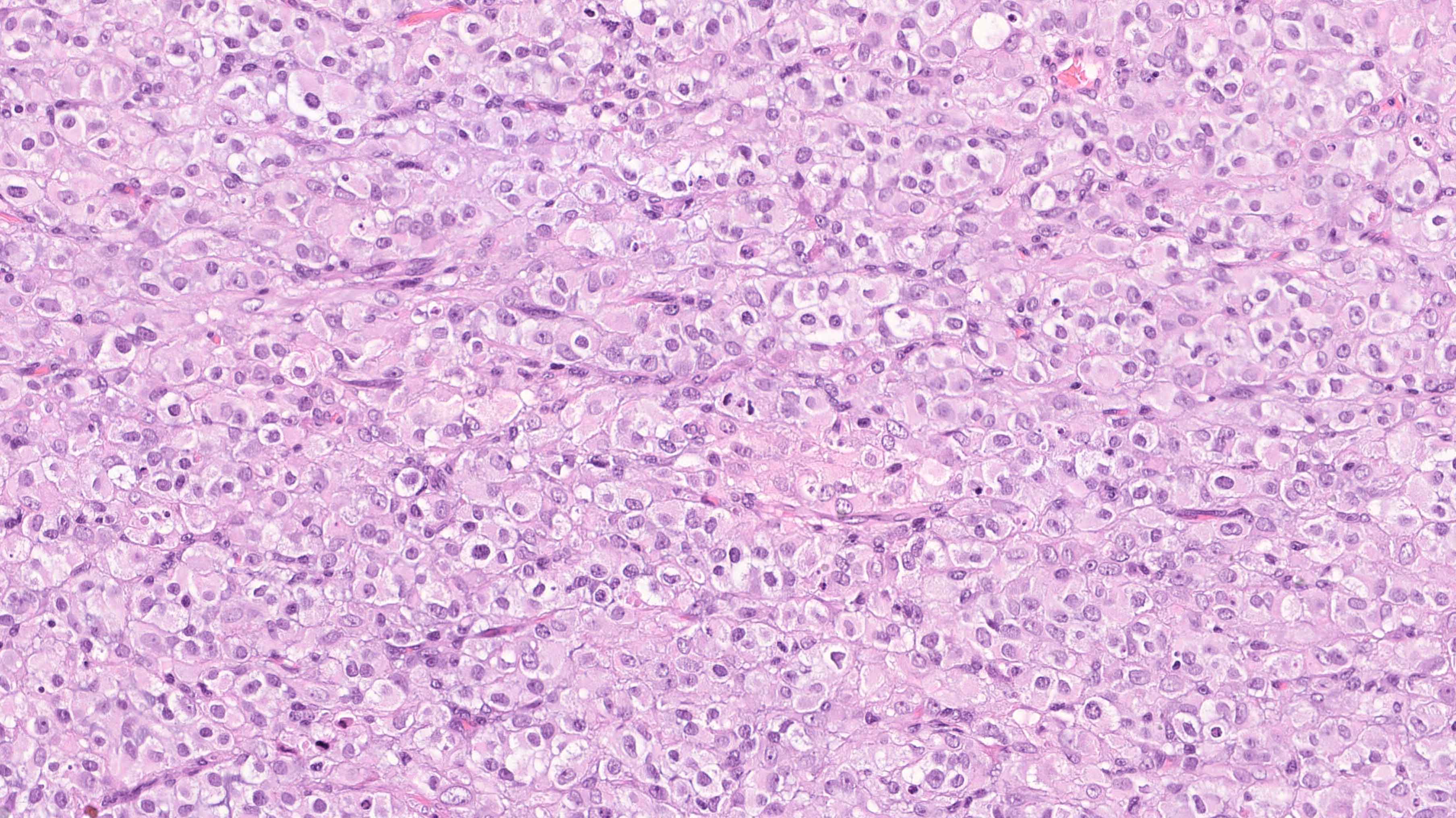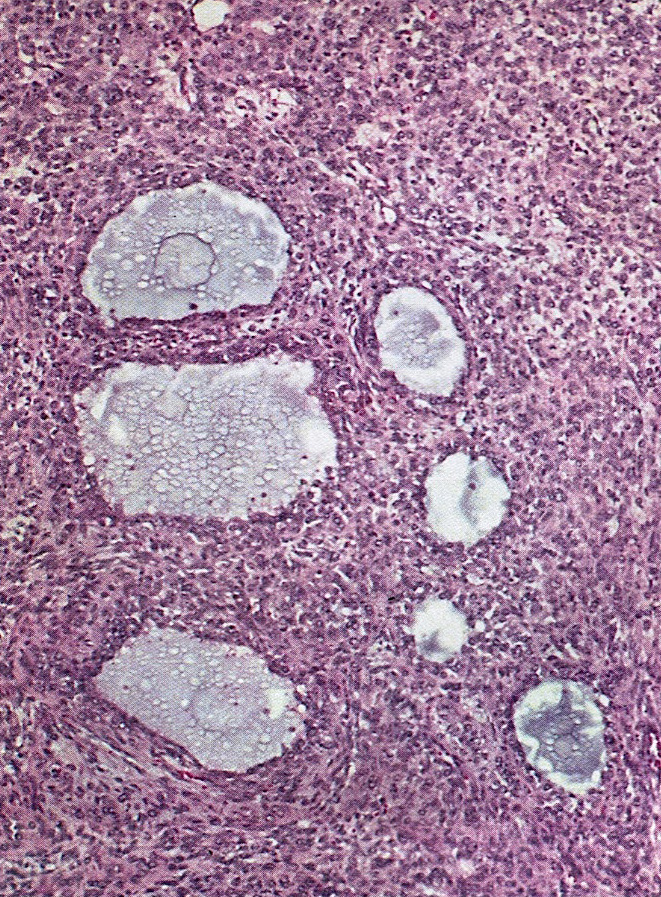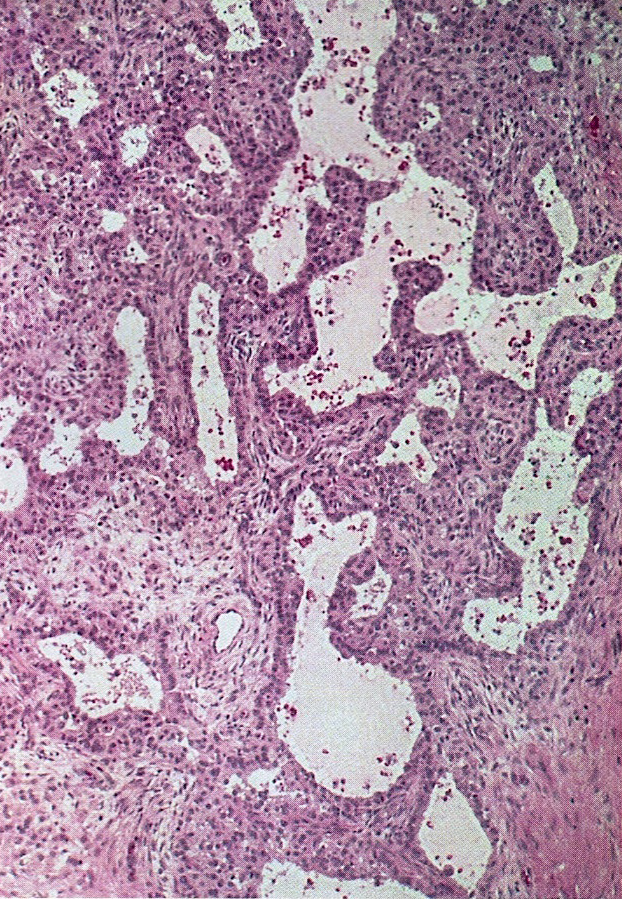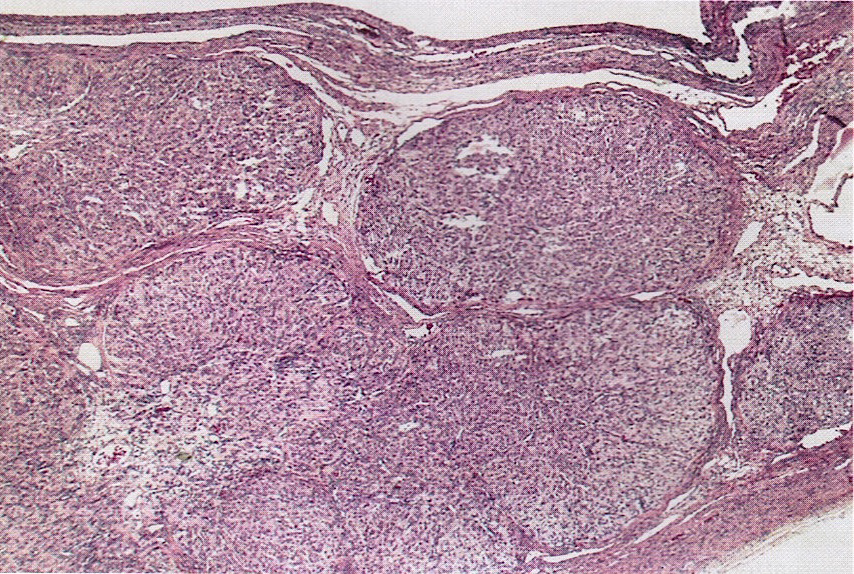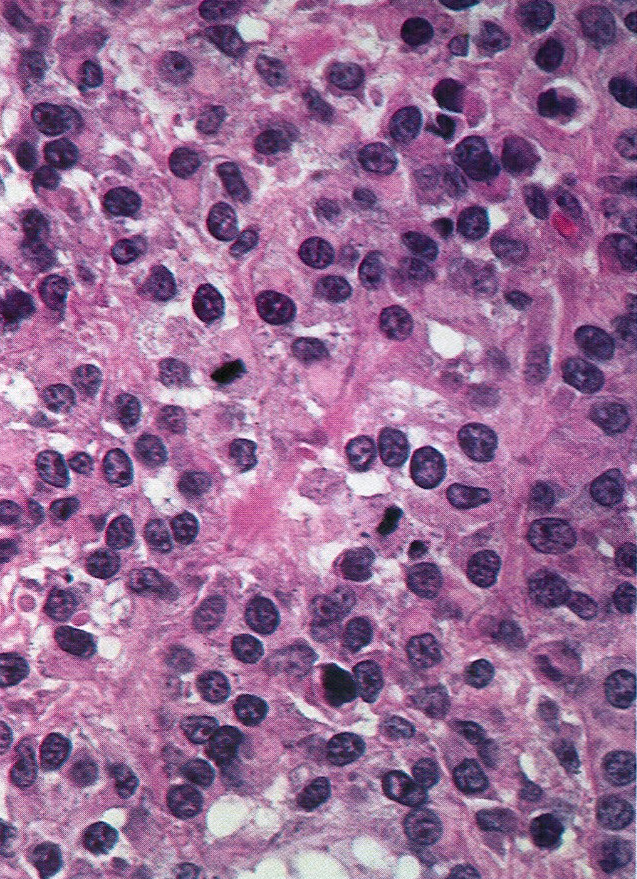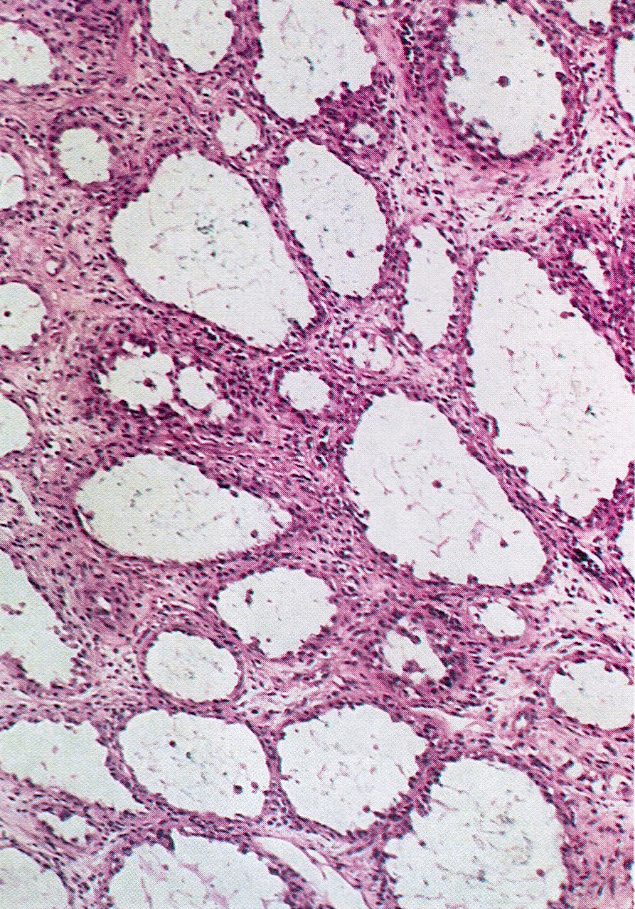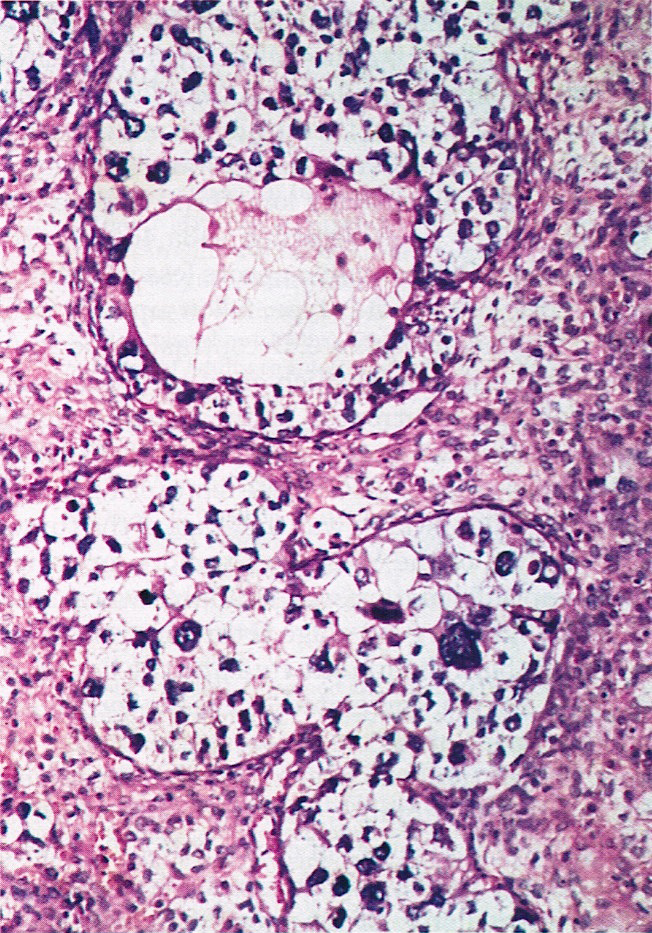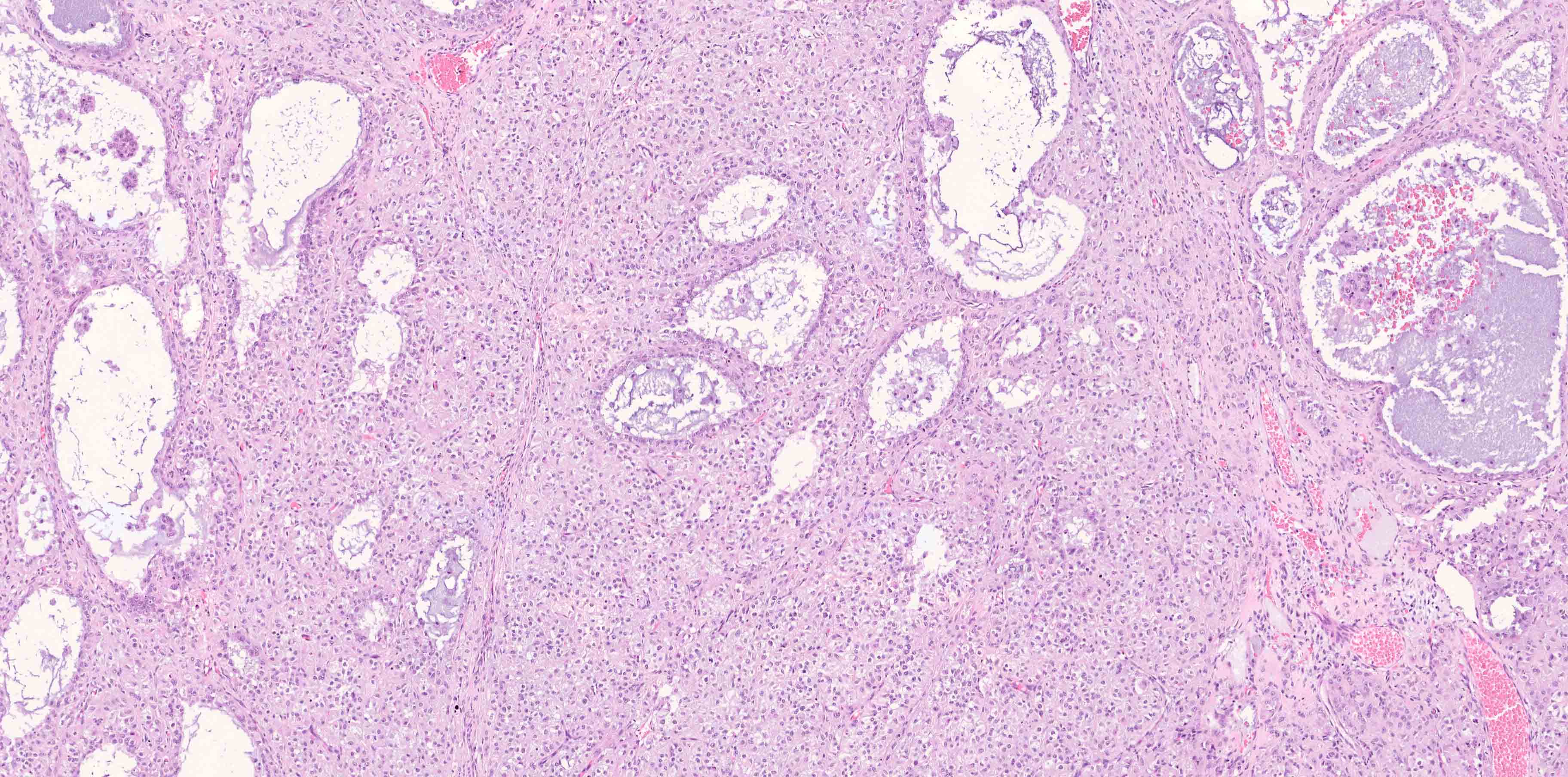Table of Contents
Definition / general | Essential features | ICD coding | Epidemiology | Sites | Pathophysiology | Etiology | Clinical features | Diagnosis | Radiology description | Prognostic factors | Case reports | Treatment | Gross description | Gross images | Frozen section description | Microscopic (histologic) description | Microscopic (histologic) images | Virtual slides | Positive stains | Negative stains | Molecular / cytogenetics description | Sample pathology report | Differential diagnosis | Additional references | Board review style question #1 | Board review style answer #1Cite this page: Huvila J, Gilks CB. Granulosa cell tumor-juvenile. PathologyOutlines.com website. https://www.pathologyoutlines.com/topic/ovarytumorgctjuv.html. Accessed April 25th, 2024.
Definition / general
- Sex cord stromal tumor composed of primitive appearing granulosa cells with follicular and solid growth patterns
Essential features
- Sex cord stromal tumor with primitive granulosa cell differentiation
- Solid and follicular growth
- Almost always occurs in patients younger than 30 years
- Lacks the FOXL2 somatic mutation seen in adult granulosa cell tumor
- Usually stage IA and associated with a favorable prognosis
ICD coding
- ICD-O: 8622/1 - granulosa cell tumor, juvenile
- ICD-10:
- ICD-11: 2F76 & XH2KH2 - granulosa cell tumor, juvenile
Epidemiology
- Mean age 13 years; range 0 - 67 years
- 80% occur before age 20 and 97% before age 30 (Am J Surg Pathol 1984;8:575)
Sites
- Ovary
- Rarely extraovarian (Pediatr Hematol Oncol 2021;38:272)
Pathophysiology
- Unknown
Etiology
- Unknown
Clinical features
- Most prepubertal patients present with sexual precocity due to excessive estrogen production and rarely produce androgens; older patients have nonspecific abdominal swelling and pain (J Endocrinol Invest 2006;29:653, Am J Surg Pathol 1984;8:575)
- Rarely associated with enchondromatosis (Ollier disease), Maffucci syndrome, abnormal karyotype / ambiguous genitalia (Am J Surg Pathol 1984;8:575, Am J Surg Pathol 1985;9:737)
Diagnosis
- Diagnosis is made at the time of removal of an adnexal mass
- Possibility of juvenile granulosa cell tumor may be suspected if there are estrogenic manifestations in a prepubertal patient but histopathological examination is required for diagnosis
Radiology description
- Typically appears on imaging as a large, unilateral, multicystic mass with occasional septae; most contain both solid and cystic components
- Can have a sponge-like appearance on imaging (Radiographics 2014;34:2039)
Prognostic factors
- Of low malignant potential, with a very favorable prognosis for patients with stage IA tumors (which account for a large majority of cases) but a guarded prognosis if there is spread beyond the ovary
Case reports
- Fetus with an androgenic ovarian mass in the third trimester (J Obstet Gynaecol Res 2021;47:2220)
- 2 year old girl with precocious pseudopuberty (J Clin Res Pediatr Endocrinol 2021 Apr 14 [Epub ahead of print])
- 17 year old girl with gender dysphoria (Case Rep Oncol 2020;13:1330)
- 33 year old woman with adnexal mass and Maffucci syndrome (Clin Imaging 2019;56:77)
- 40 year old Japanese woman with late onset juvenile granulosa cell tumor (Acta Med Okayama 2020;74:159)
Treatment
- Large majority of tumors are stage IA and surgical removal, with preservation of fertility if desired, is all that is required for treatment (Acta Obstet Gynecol Scand 2021 May 24 [Epub ahead of print])
- With recurrent or advanced stage tumors, platinum based chemotherapy is typically offered (Acta Obstet Gynecol Scand 2021 May 24 [Epub ahead of print])
Gross description
- Usually unilateral with a smooth surface
- Mean size 12.5 cm (Am J Surg Pathol 1984;8:575)
- Multiloculated, cystic and solid tumor with yellow-white solid areas
- May have hemorrhage and necrosis
Gross images
Frozen section description
- Smooth surfaced ovarian mass in a young patient
- Presence of follicular differentiation is helpful but definitive diagnosis may have to be deferred to permanent sections
Microscopic (histologic) description
- Diffuse or nodular appearance at low power
- Macrofollicle and microfollicle formation containing eosinophilic secretions
- Tumor cells are often luteinized
- Round / oval hyperchromatic nuclei with small nucleoli, irregular nuclear contours
- No / rare nuclear grooves; high mitotic rate (mean 11/10 high power fields) (Arch Pathol Lab Med 1989;113:40)
- Bizarre / atypical nuclei are rarely present
- May have pseudopapillary architecture (Am J Surg Pathol 2008;32:581)
Microscopic (histologic) images
Positive stains
Negative stains
Molecular / cytogenetics description
- Most have AKT1 mutations (EBioMedicine 2015;2:421)
- GNAS mutations reported in 30% of cases (J Clin Endocrinol Metab 2006;91:1842)
- Consistently negative for FOXL2 (402C > G) mutation, while 5 - 10% have a mutation in DICER1; the DICER1 mutations may be germline, i.e. associated with DICER1 syndrome (Am J Surg Pathol 2021;45:223)
- Somatic mutations in IDH1 or IDH2 are associated with Ollier disease or Maffucci syndrome; juvenile granulosa cell tumor is an uncommon manifestation of both diseases (Am J Med Genet A 2020;182:1093)
Sample pathology report
- Right ovary, oophorectomy:
- Juvenile granulosa cell tumor, negative for ovarian surface involvement or extraovarian spread
Differential diagnosis
- Adult granulosa cell tumor:
- Older age at presentation (but there is some overlap in the age ranges)
- Small uniform cells resembling normal granulosa cells
- FOXL2 mutation in 95% of cases (N Engl J Med 2009;360:2719)
- Small cell carcinoma, hypercalcemic type:
- More primitive appearing cells, with scant cytoplasm or rhabdoid cells
- Loss of BRG1 expression (protein encoded by SMARCA4) (J Pathol 2016;238:389)
- Mutation in SMARCA4 (Nat Genet 2014;46:427)
- Sertoli-Leydig cell tumor:
- Tubules (in well differentiated tumors), cords (intermediate differentiation), sarcomatoid growth (poorly differentiated) or retiform architecture
- Follicle-like spaces occasionally seen admixed with typical sertoliform differentiation (Am J Surg Pathol 2021;45:59)
- Gynandroblastoma:
- Typical Sertoli-Leydig cell tumor component coexisting with separate typical juvenile granulosa cell tumor (Am J Surg Pathol 2021;45:59)
- Yolk sac tumor:
- Clear cell carcinoma:
Additional references
Board review style question #1
A 2 year old girl presents with a unilateral ovarian tumor. Histology shows follicle-like spaces lined by cells with moderate amounts of cytoplasm and showing nuclear atypia and prominent nucleoli. What is the diagnosis?
- Juvenile granulosa cell tumor
- Sertoli-Leydig cell tumor
- Teratoma
- Yolk sac tumor
Board review style answer #1





